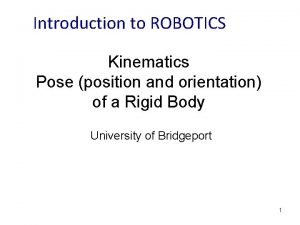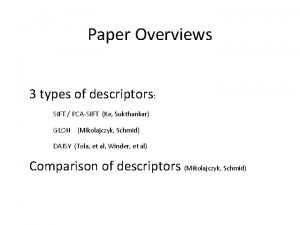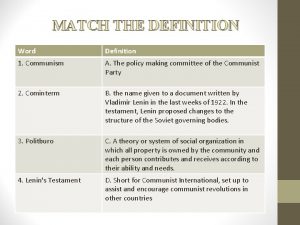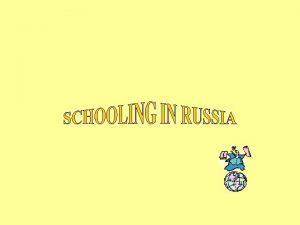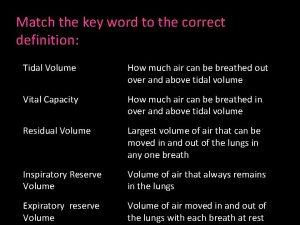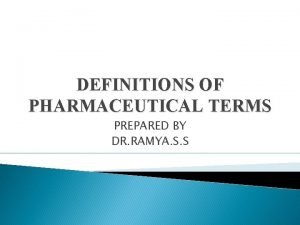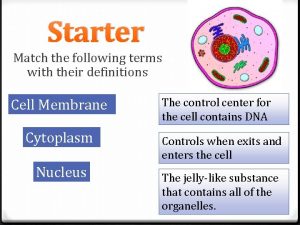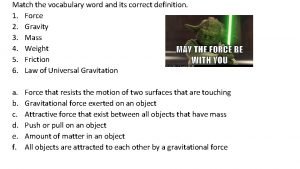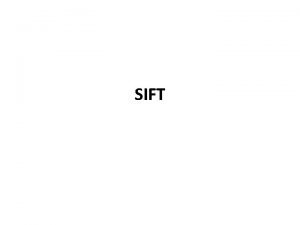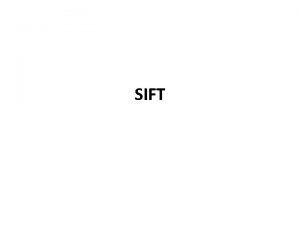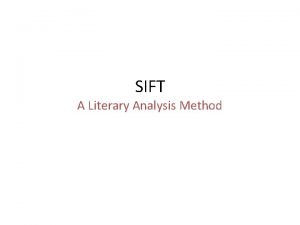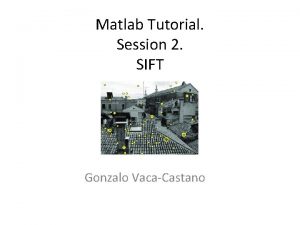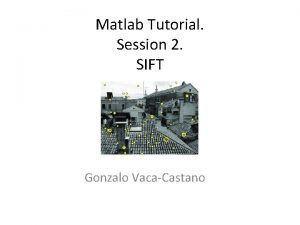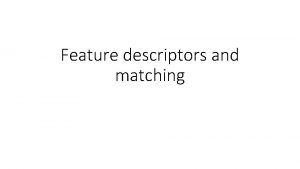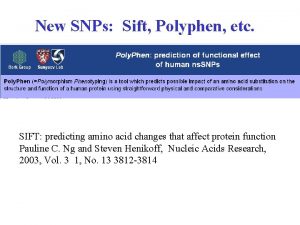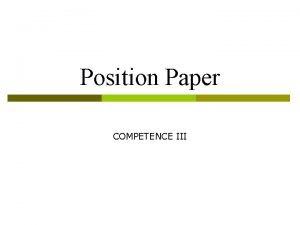SIFT paper Terms Definitions Pose position orientation of















- Slides: 15

SIFT paper

Terms & Definitions • Pose = position + orientation of an object • Image gradient = change in brightness (orientation dependent) • Scale = ‘size’ of features. Gaussian filters eliminate ‘smaller’ features • Octave = a set of scales that goes up to a double, e. g. 1, sqrt(2), 2 is an octave.

Overview • Scale space extrema detection – Potential image points from Do. G function, invariant to scale and orientation • Keypoint localization – Choose stable locations & determine their exact position & scale • Orientation assignment – Assign keypoint orientation based on image gradients • Keypoint Descriptor = final representation

Using the SIFT • Collect keypoints for each reference image and store in database • Collect keypoints for the ‘unknown’ image • Look for clusters of matches – Agree on object, scale, and image location • Compute probability of object, given features

Related Research • Corner & feature detectors (Moravec, Harris) • Feature matching into database (Schmid & Mohr) • Feature scale invariance (Lowe) • Affine invariant matching (many) • Alternative feature types (many)

Detection of Scale Space Extrema • Scale space: (x, y, sigma) – Sigma is parameter of a Gaussian function • Extrema in scale space – Pixel whose values is max (min) of local window • Difference of Gaussian function – D(x, y, sigma) = (G(x, y, k*sigma) – G(x, y, sigma)) * I(x, y) – first create Do. G kernel, then convolve with image

Difference of Gaussian http: //fourier. eng. hmc. edu/e 161/lectures/gradient/node 11. html

Local Extrema Detection Szeliski: Fig 4. 11

How many scales? • In Section 3. 2, experiments show: – Repeatability peaks at 3 scales / octave, then slowly drops off – Number of keypoints grows as scales grow, but slowly than linear (appears approx. log) • Bottom line: they chose 3 scales / octave

Keypoint localization • Initial implementation: location/scale of keypoint taken from pixel coordinates in scale space • Improved implementation: – Fit 3 D quadratic function to local sample points – Return coordinates of peak of fit function (subpixel) – see equations 2 and 3 – If value of D(x, y, sigma) is too small, reject due to low contrast

Avoiding Edges • A point on an edge does not localize well (it can slide along the edge) • Compute Dxx, Dxy, Dyy (as we did last week) • Tr(H) = Dxx + Dyy • Det(H) = Dxx. Dyy – Dxy*Dxy • If (Tr(H)*Tr(H))/Det(H) > 12. 1 (using r of 10), then location is eliminated (max curvature / min curvature > 10)

Keypoint Orientation • Depends on local image properties (e. g. intensities) • Choose the Gaussian smoothed image L at the keypoint’s scale • Compute gradients using horizontal and vertical [1 0 -1] masks (call them H and V) – Gradient magnitude = sqrt(H*H+V*V) – Gradient direction = atan(V/H)

Orientation Histogram • Collect orientations in window around sample point – Weights fall off based on Gaussian with sigma that is 1. 5 times scale • Build histogram (36 bins) of weighted orientations – Peak of histogram is keypoint orientation – Any other peaks within 80% are additional keypoint orientations

Local image descriptor • Each keypoint has image location, scale, and orientation • Descriptor is array of histograms of orientations surrounding the keypoint (See Fig. 7) • Array is normalized to reduce effects of lighting

Application: Object Recognition • Match each keypoint independently to database (nearest neighbor) • Find clusters of at least 3 features that agree on object, position and orientation (pose) • Perform detailed geometric fit to model and accept or reject
 Position vector
Position vector Sift paper
Sift paper Ballet terms and positions
Ballet terms and positions Carburizing flame definition
Carburizing flame definition A quick primer
A quick primer What is communism in simple words
What is communism in simple words Has no dimension; is one of the undefined terms of geometry
Has no dimension; is one of the undefined terms of geometry Restaurant terms and definitions
Restaurant terms and definitions Match the words with the correct definitions
Match the words with the correct definitions Match each key term with the correct definition
Match each key term with the correct definition Undefined terms and basic definitions worksheet answers
Undefined terms and basic definitions worksheet answers Pharmacopedics
Pharmacopedics Match the following terms to their definitions
Match the following terms to their definitions Drama elements plot
Drama elements plot Match the vocabulary word with the proper definition
Match the vocabulary word with the proper definition Ethnocentric company
Ethnocentric company
